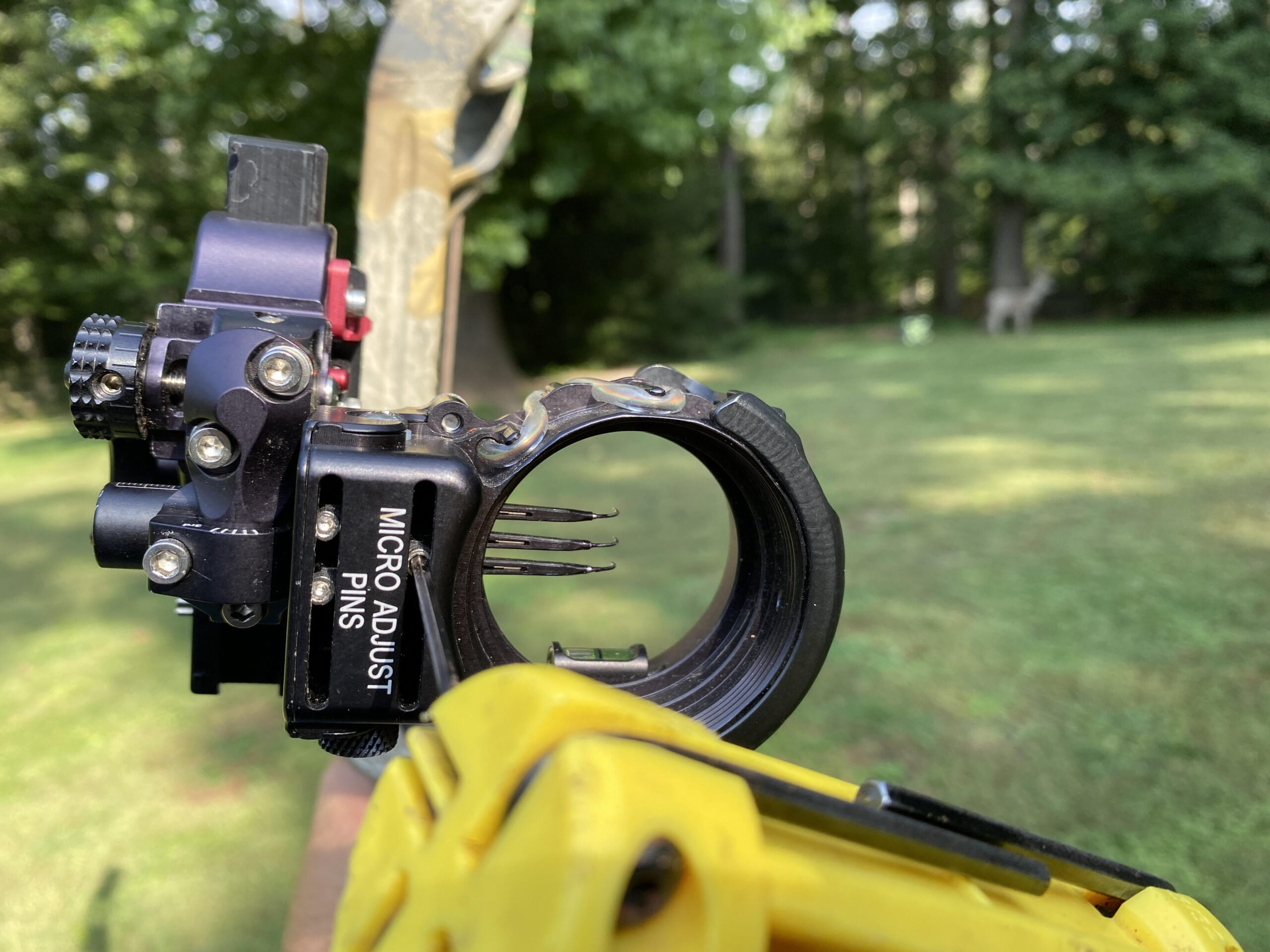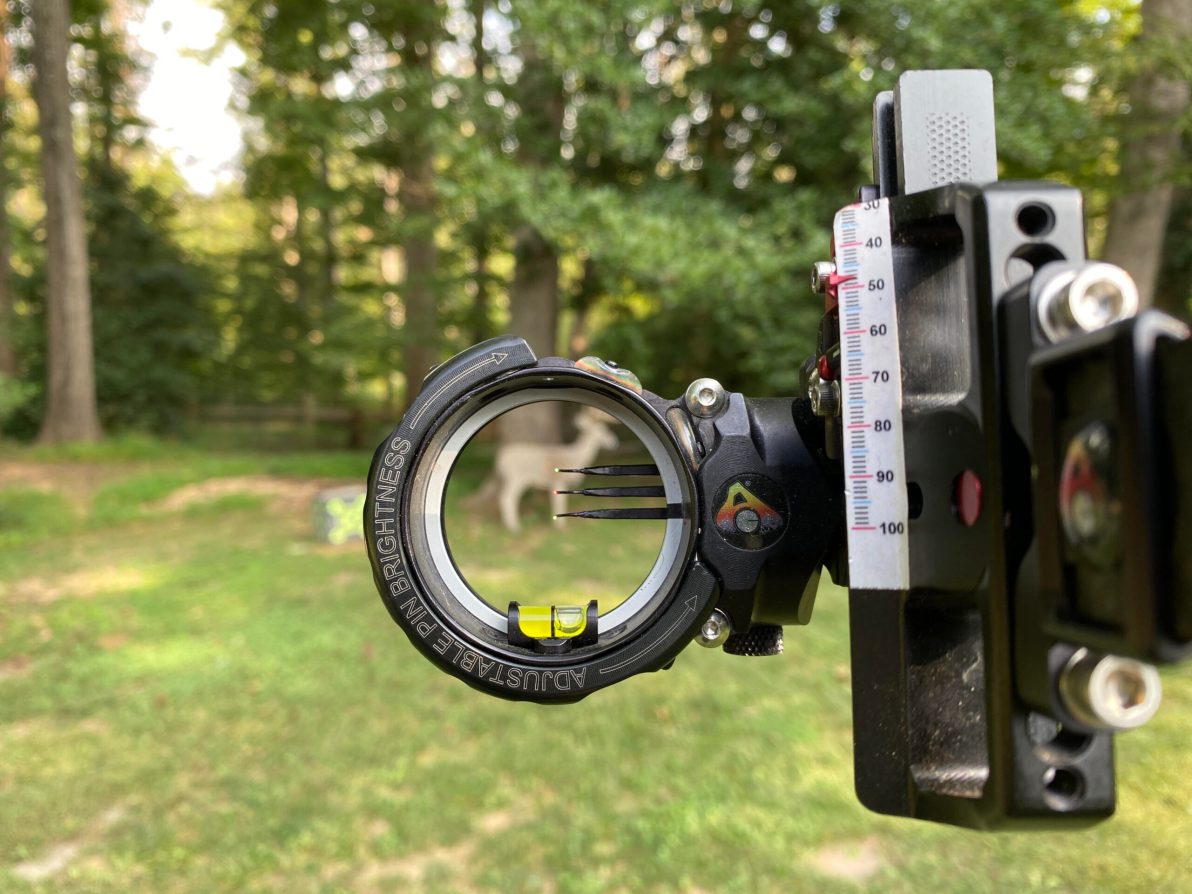We may earn revenue from the products available on this page and participate in affiliate programs. Learn More ›
Bowhunting season is fast approaching, and it’s time to get your compound rig dialed in. Maybe you got a new bow, or maybe you got a new sight. Regardless, you’ve got to set your bow sight so you can count on it to provide an accurate aiming reference when the moment of truth comes. Today’s compound bows are deadly accurate, but only if the sights they carry are precisely set. Here’s a guide on how to sight in a compound bow.

How to Sight in a Compound Bow: Before You Begin
The first step when it comes to how to sight in a compound bow is making sure the bow is tuned and your sight is leveled. A tuned bow is one which has the rest and nocking point perfectly aligned so arrows leave the bow perfectly straight. If the bow — or archer — isn’t shooting straight, you can waste a lot of time trying to sight in.
Leveling your sight is key to making sure that as you shoot at different distances, the left-right alignment of the sight stays true. If the sight sits on the bow at an angle, then every pin or sight reference you try to set after the first one will be off to the left or right. If you take your bow to an archery shop the technician there can level your sight and tune your bow. If you’re a do-it-yourselfer, head to YouTube and your sight’s directions will guide you on the process.
Today’s compound sights essentially can be broken into two main categories — multi-pins and single pins. Let’s talk about how to sight in each.
How to Sight in a Multi-Pin Sight

With a multi-pin sight, you typically have three, five, or seven sight pins that you set as aiming references for different distances. On a bowhunting sight, the most common way to set pins on a five-pin sight is to position them for aiming at 20, 30, 40, 50, and 60 yards, with the 20-yard pin being the highest aiming reference in the scope and the 60-yard pin being the lowest. Let’s assume that arrangement.
For your first shot with a new sight, you’ll have no idea where that arrow is going to hit in relation to the bow sight pins, so start out shooting no farther than 10 yards. And shoot into a large target — one with lots of room up and down and left and right. A large target provides room for error.
Place a bull’s-eye in the center of the target and shoot at it from a distance of 10 yards, using your top pin as the aiming reference. Note where the arrow hits the target in relation to the bull’s-eye. The general rule you’ll follow when adjusting your sight is to always move the sight in the direction your arrows are hitting. For example iIf the arrow hits high, move the pin up, and if the arrow hits to the right, move the pin to the right.
Keep in mind you will need to have vertical room within your scope for however many pins your sight has. If you have five pins, you want that 20-yard pin near the top of the scope in order to have enough room in the scope for pins set at 10-yard increments out to 60 yards. So when you set your 20-yard pin, put the pin high in the scope and then adjust the whole scope up and down and left and right until your arrow hits behind the pin at 20 yards. Now lock the scope in position.
Once you feel confident your 20-yard pin is on, back up to 30 yards and shoot at the bull’s-eye again, using your 20 pin to aim. Note where your arrow hits and move your second-highest pin into position. This time — and for every pin afterwards — you’re only moving the pin, as opposed to the whole scope. Keep shooting and moving that pin until your arrow consistently hits behind it.
For your 40-yard pin, look at the gap between your 20 and 30-yard pins and move your third-highest pin until the gap between it and the 30-yard pin looks similar to the gap from 20 to 30. Now shoot from 40 yards away using that third pin to aim. Adjust until your arrow hits behind it. Repeat this process to set your 50 and 60-yard pins.
If your scope is properly leveled before you start, you should only have to move pins vertically after you zero your 20-yard pin. For windage, the 30, 40, 50, and 60 pins all should simply sit directly under the 20 in a straight, vertical line.

How to Sight in a Single Pin Sight
Adjustable sights with just one pin or other aiming reference are a little trickier to sight in, just because it’s difficult to gauge the initial adjustments. Trouble is easy to avoid, however, if you shoot into that same large target that offers plenty of room for error.
Single-pin sights require the archer to adjust the scope housing up and down to shoot at different distances. So these employ a sight tape, which is a yardage guide fixed to the sight body. There will be a movable indicator which adjusts between pre-set distances as the archer moves the scope housing.
The indicator points to the sight tape, which has the yardage markings printed on it. Most single-pin sights are sold today with multiple pre-printed sight tapes that vary based primarily on arrow speed. It’s up to the archer to figure out which sight tape fits their setup.
Start with a blank tape to get a 20-yard mark. Start that process by moving your sight pin as far up as it can go, and then take a shot at a dot in the very center of your target from a distance of 10 yards to see where your arrow hits in relation to the pin. The arrow should hit low if your pin is moved as high as it can go. Adjust your pin vertically and horizontally until the arrow hits behind it, and then back up to 20 yards and repeat the process.
Once you are confident your pin is dead on at 20 yards, draw a line on the blank sight tape to mark where your indicator is positioned. Now back up to 40 yards and repeat the process, including marking your indicator location. Do this one more time at 60 yards until you have solid 20, 40, and 60-yard marks.
Now go to your pre-printed sight tapes and hold them up to the marks you just made until you find one where your marks line up with the 20, 40, and 60 measurements on the pre-printed tape. That’s the tape you want to affix to your sight. It should provide accurate yardage marks for any distance you want to shoot. Test it by moving the indicator to different yardages and shooting from those distances.
The Upshot
Learning how to sight in a compound bow is a fundamental archery skill that will come in handy throughout your archery career. Here are a few final tips to keep in mind when taking on this task: don’t just settle for close enough and shoot each shot with your best form possible. Take the time to make good shots and properly dial in your sight, and the dividends will be paid in the field.
